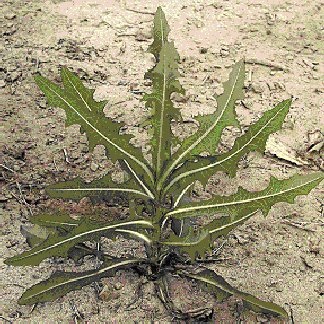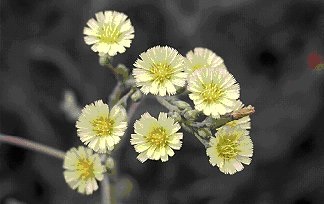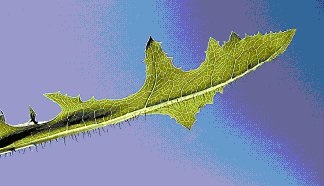Prickly lettuce
Learn how to identify prickly lettuce and control options.
ISSN 1198-712X, Published July 2003
Description and life cycle
Prickly lettuce is a winter annual weed often found in no-till soybeans and winter wheat, or along field edges. It is sometimes referred to as "wild lettuce", because it is closely related to, and inter-fertile with, cultivated lettuce. Another common name is "compass plant", because the leaves on the main stem are held vertically in a north-south plane, perpendicular to direct sunlight. (Figure 1) The French common name for prickly lettuce is "laitue scariole", which derives from its scientific name, Lactuca serriola or Lactuca scariola.
Prickly lettuce forms a rosette of leaves after emergence, usually in autumn, and develops a long taproot. It overwinters as a rosette, and then produces one or more flowering stems in early summer. Each flowering stem bears many small (8-12 mm in diameter) yellow flower heads during July and August. (Figure 2) The small, greyish brown seeds (4-5 mm long) have an attached pappus and are wind-dispersed. The leaves, roots and stems exude a milky juice when damaged.
Prickly lettuce may be mistaken for dandelion, at the rosette stage, or for sow-thistles at any stage. All of these species are members of the sunflower family, contain a milky latex, have yellow flowers and produce numerous wind-dispersed seeds. A distinguishing feature of prickly lettuce is a row of spines along the midrib on the underside of the leaf. (Figure 3) These spines are occasionally absent from small, upper stem leaves or from leaves on stems that have regrown after mowing.
Prickly lettuce is native to the Mediterranean region, and was introduced to Ontario in the late 1890's, subsequently spreading by seeds along roadsides, railways and watercourses throughout most of southern Canada. It remained a weed of roadsides and waste ground until the adoption of reduced tillage systems provided an opportunity to thrive in crops. The absence of tillage in the autumn or spring allows this weed to complete its life cycle undisturbed. The wind-dispersed seeds often catch and settle on crop stubble or residue found in no-till fields.
Most emergence occurs in the autumn, beginning in late September and extending into November in the warmer parts of Ontario. A long, warm autumn favours emergence and rosette establishment, and often results in large populations the following year. Some emergence (<25% of the population) also occurs in the spring before most crops have been planted. Plants that emerge in spring have a shorter rosette phase before flowering and are often smaller than plants emerging in autumn. All plants die after flowering.
Seed production is proportional to plant height. Plants that are 0.5 m tall produce about 35 flower heads, where-as plants that are 1.5 m tall can produce as many as 2,300 flowers. Each flower head contains an average of 20 seeds, giving an estimated seed production of 700 and 46,000 seeds per plant, respectively. Most seeds are viable and ready to germinate immediately after dispersal. Prickly lettuce forms only a short-term seed bank, with seeds surviving 1–3 years in soil.
Economic impact
Prickly lettuce is drought tolerant and competes strongly with soybeans for water in a dry season, resulting in reduced yield. In winter wheat it can have detrimental effects on crop value and harvesting efficiency. If the plant is in flower at grain harvest, the flower buds can be difficult to screen out of the grain, resulting in discounted prices. The sticky white latex in the stems can clog harvesting equipment and raise the moisture content of the grain. Stem latex is less of a problem at soybean harvest, when plants have senesced and stems have dried.
Cattle feeding exclusively on fresh, young prickly lettuce plants have been reported to develop pulmonary emphysema, but mature plants and dried younger plants appear to be non-toxic. Prickly lettuce has been declared a noxious weed in Manitoba, but not in any other province.
Control
Seedlings and rosettes of prickly lettuce are easily controlled by cultivation, and it is not usually found in tilled fields. Mowing of rosettes is not an effective control practice, because leaves lie close to the soil surface. Plants that are mown after stem extension readily produce new stems or branches and flowers.
Rosettes of prickly lettuce can be controlled in the fall or spring by non-selective herbicides containing glyphosate, glufosinate ammonium, or paraquat, with larger rosettes requiring higher rates. Plants are difficult to control with herbicides once the flowering stems have begun to elongate. Preemergence applications of products containing atrazine, metribuzin, napropamide, chlorsulfuron, isoxaben, oxyfluorfen, oxadiazon or terbacil will usually control germinating seedlings. Postemergence applications of 2,4-D, MCPA, dicamba, clopyralid, bromoxynil plus atrazine, metribuzin, linuron with oil, or thifensulfuron-methyl/tribenuron-methyl, can control prickly lettuce rosettes in a variety of crops. Postemergence application of products containing cloransulam-methyl or chlorimuron-ethyl in soybeans provide suppression but not complete control. Consult the latest edition of OMAFRA Publication 75, Guide to Weed Control, for trade names, crop registrations and rates of these products.
Prickly lettuce has acquired resistance to Group II herbicides in the northwestern United States and Australia. Although herbicide resistance in this species has not yet been found in Canada, rotation of herbicide groups and crops is recommended to prevent the development and spread of resistant plants.


